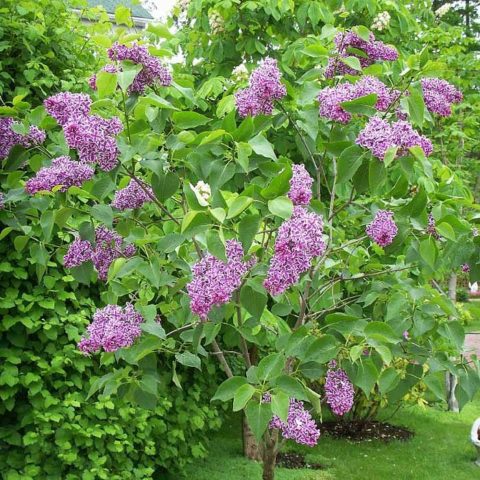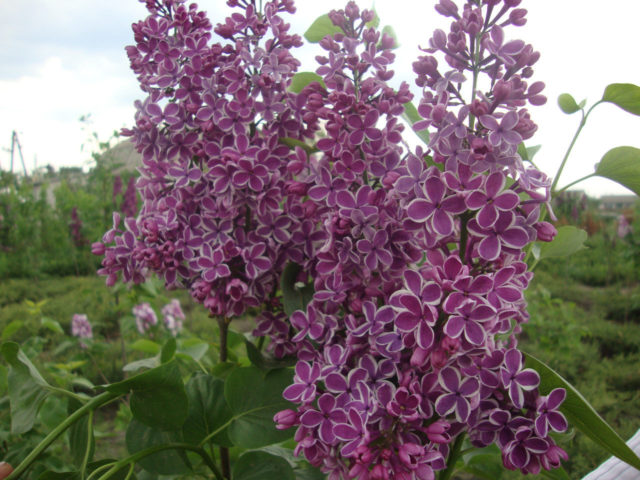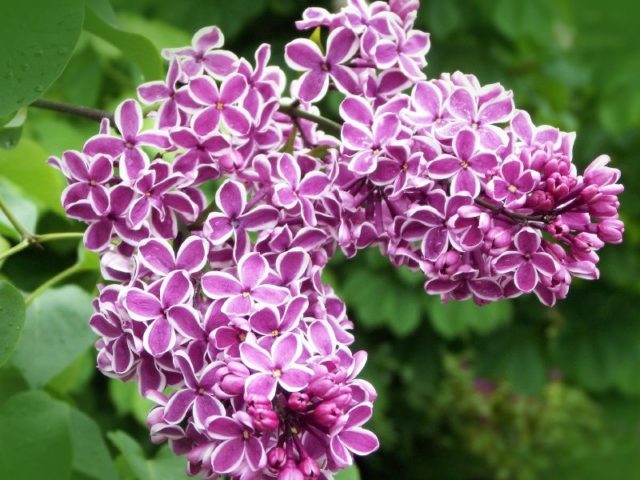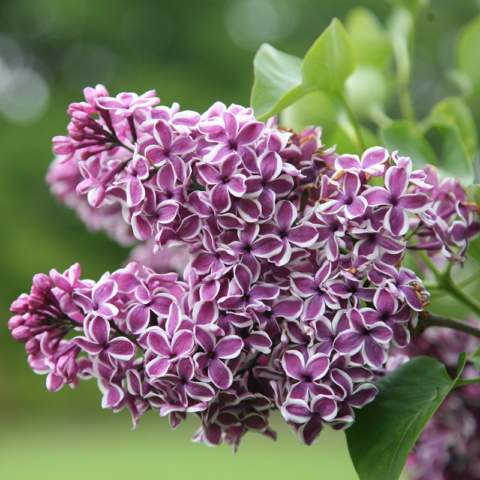Content
Every gardener wants to make his site beautiful and unique. Photo and description of lilac The sensation presented below will help you choose the right place and time for planting, as well as give the necessary knowledge about caring for the plant. This will produce a beautiful flowering shrub that is pleasing to the eye during the warm summer months.
Description of Lilac Sensation
The plant belongs to the olive family. For the first time this type of lilac was bred in France. It has a wonderful light aroma. Lilac Sensation is a deciduous shrub with an even crown up to 3 m high. The branches of the plant are spreading, large pointed leaves reach a length of 10 cm. This plant is most popular with gardeners for its excellent resistance to frost and the greatest resistance to pests.
Currently, it is widely used for landscape design and decoration of garden and house plots. This variety of lilac can be used to create a hedge, or can be planted with separate bushes. Best of all, the Sensation is combined with species of lilacs blooming in white - the alternation of such bushes will give an impressive effect.
How the lilac blooms Sensation
Lilac blooms luxuriantly and very densely. Flowers are collected in a panicle inflorescence. Each inflorescence consists of either one or two panicles. Each flower is up to 20 cm long and up to 8 cm wide. Each flower has lilac petals with a small white border around the edges.
The time to bloom may vary depending on weather conditions and the growing region. In the middle lane, the Sensation begins to bloom around mid-May. The duration of flowering is on average 30-35 days. Flowers do not appear on the panicle all at once, but one after another. Each panicle blooms for about 13-19 days, while the lifespan of each flower is 9-12 days. To get a great photo of the common Sensation lilac, it is best to choose a medium flowering period, when most of the flowers are already in full bloom.
Breeding features
Every gardener year after year tries to increase the number of plants on his site. Traditionally, among the most common breeding species of lilacs, the Sensation is distinguished by:
- graft;
- cuttings;
- layering;
- seed reproduction.
Among these methods, the most popular is cuttings. Annual green shoots with 4-5 leaves are used as cuttings. Shoots are cut during the flowering period of the bush - at this time, the Sensation stops gaining green mass. For cutting cuttings, it is best to choose the youngest plant possible.
Cuttings are cut at an angle and treated with a special tool to accelerate the formation of roots - root. The seedlings are planted in greenhouses with high humidity. After 2-3 months, the plant will release its roots and is ready for further planting.
Lilac planting rules Sensation
Planting Sensations is not difficult even for a novice gardener. At the same time, following the rules will allow you to get the most healthy plant. The most important thing is to observe the correct planting dates, choose the right place and soil, and prepare the planting holes in advance.
A planting hole must be dug for each plant. The best pit size is a depression with sides of 50 cm and a depth of 70-80 cm. At the bottom of each pit, a layer of drainage from rubble or broken brick is laid.
Recommended timing
Saplings of common lilac Sensation are planted either in spring or early autumn. The first months of September are considered the best time to plant. At this time, the grown seedlings are ready for wintering. Lilacs thrive best in cold weather, when night temperatures drop to 7-9 degrees.
If a spring planting is planned, the ideal time is considered to be early to mid-April. The soil at this time has already thawed and warmed up well for the active development of roots. Do not delay planting - the longer the lilac gets used to the prepared place, the more difficult its first wintering can become.
Site selection and soil preparation
Lilac prefers well-lit areas, so the best place to plant it is on the southwestern slopes. The more sun the plant receives in the spring, the more active its vegetation and flowering will be. Placed in shaded areas, the Sensation can give up blooming entirely.
In terms of soil, the plant thrives best in a neutral or alkaline environment. It is believed that the best soil for lilacs is clay soil with good drainage. If the environment is too acidic, additional fertilizers can be added to alter the alkaline balance of the soil.
How to plant correctly
Each seedling is placed in a planting hole prepared in advance. The root collar should be 2-3 cm higher than the ground level. Each hole is covered with prepared earth at the rate of 1 part of sand and turf soil for 2 parts of leafy soil.
If the lilacs are planted singly, then it is necessary to observe a distance of 2-3 m between each bush. If the Sensation is planted in a heap, then a larger hole is dug and 4-5 seedlings are planted in each of them. Alley planting in a row means the distance between each of the bushes is 1-1.5 m.
It is also recommended to prepare fertilizers - 20 kg of compost, 300 g of wood flour, 30 g of superphosphate. All ingredients are mixed and about 2-3 kg of such bait are added under each bush. Each planted bush is watered with 10-15 liters of water. Such abundant watering stimulates the rooting process well. Moreover, if the planting is carried out in the fall, it is advisable to reduce the amount of watering, since the plant is almost ready for wintering.
Growing lilacs Sensation
Variety Sensation, like other varieties of lilacs, is unpretentious and not very demanding in care. Nevertheless, it is worth following some guidelines that will allow you to get the most healthy plant possible.
In order for the lilac to bloom profusely, it needs proper periodic watering and timely feeding with organic fertilizers. The soil needs to be mulched periodically. In addition, each plant in the garden must be properly pruned - this will improve the splendor of the flowering and allow you to get a beautiful crown.
Watering
The first watering of lilacs Sensation is made after direct planting in open ground. This watering is most important for the seedling to take root. It is best to add a certain amount of root in the first watering for accelerated development of the lilac root system.
The next watering is done when the soil around the lilac is completely dry. Sensation is a very moisture-loving variety of lilacs, so it is necessary that the soil around the plant is always moist.The most abundant watering must be provided to the plant during the beginning of flowering.
Top dressing
Lilac does not require a lot of fertilizers and mineral additives. The first feeding of the plant is carried out at the time of planting the seedlings. At the same time, they try to limit the use of chemical compounds. It is best to use cow dung. In cases where the soil is too acidic, add a small amount of superphosphate.
Subsequent feeding of lilacs Sensation is made only after 3 years from the moment of planting. In this case, it is best to restrict yourself to organic fertilizers again. You can apply a small amount of complex mineral fertilizer for flowering shrubs.
Mulching
Each flower plant requires loosening of the topsoil and additional mulching. Every spring, the trunks are loosened with a hoe or hoe. After that, a layer of mulch is spread around the trunk - oak sawdust. The layer of mulch for lilacs is thinner than for other ornamental plants. A layer up to 4-6 cm high is best suited.
In addition to oak sawdust, you can use other materials - humus, pine needles or hay. Also, inorganic materials are used as mulch for Sensation lilacs - fine crushed stone, gravel or expanded clay.
Pruning
Lilac pruning occurs in 2 stages. The first pruning occurs in early spring. When the snow melts, it is necessary to carry out sanitary pruning. At this stage, shoots damaged in winter are removed.
The second pruning of Sensations is carried out after the end of flowering in June. The plant is pruned brushes. This will ensure abundant flowering of the lilac next year. To form a beautiful crown, you can make additional pruning of the lilac. In the spring, before the buds swell, 6-7 main shoots are left in each bush. The remaining branches are removed.
Preparing for winter
Lilac Sensation perfectly tolerates the cold. The winters of the middle lane are not terrible for her, so her branches do not require additional shelter. If the shrub is grown in more northern regions with lingering frosts, it is best to cover it with a special cloth.
To prevent the roots from freezing during long frosts, a little more mulch is added to the trunk circles in the last months of autumn. Oak sawdust is best suited for lilacs - they perfectly absorb excess water, saving the plant from getting it to the roots.
Diseases and pests
Despite its high immunity, Sensation lilac is still susceptible to certain diseases. The biggest problems for the gardener are viral diseases - leaf spot, ring spot and mottling. In addition, the bushes are susceptible to fungal diseases:
- powdery mildew;
- brown spotting;
- withering.
Treatment from the presented diseases occurs with special antifungal agents. The preparations are diluted in water according to the instructions on the package and the plant is sprayed in the initial periods of the disease or for prophylaxis.
Among the pests, the most to be feared is a large number of caterpillars - they devour the leaves, thereby stopping the growth of green mass. It is also necessary to process the lilac from the ring moth and ticks.
Conclusion
Photo and description of lilac Sensation will allow the gardener to choose the right plant for his garden. Subject to the correct planting conditions and regular care, the bushes will quickly gain weight and increase the number of flower ovaries. A healthy plant will adorn any site.












